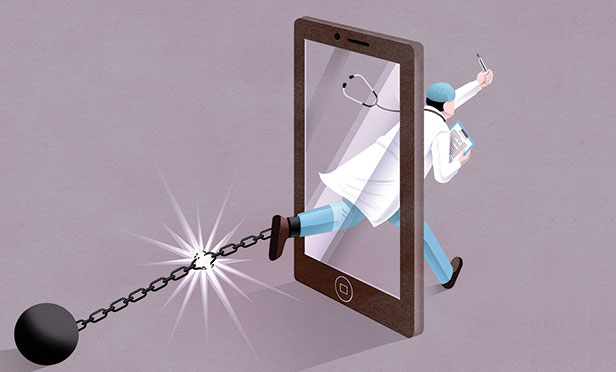 Because they now represent the largest generational slice of the workforce, millennials are rapidly driving expansion of employer plan telemedicine, and older employees are following suit. (Illustration: Marco Melgrati)
Because they now represent the largest generational slice of the workforce, millennials are rapidly driving expansion of employer plan telemedicine, and older employees are following suit. (Illustration: Marco Melgrati)
Five years ago, when talk turned to telemedicine or telehealth, the word “potential” either preceded or closely followed the discussion. In 2018, that potential is finally being realized.
You don't need to look further than a physician's office, a benefits consultant's option packages, or the details of a major employer-sponsored health plan. From online consultations to take-home self-diagnostic kits to remote specialist networks, telemedicine is suddenly everywhere.
The National Business Group on Health, which represents major employers, has charted the growing adoption of telemedicine by its members. Today, 96 percent offer some type of telemedicine benefit as part of their health plan, compared to 46 percent in 2015. NBGH's 2019 Health Care Survey confirmed the shift. “The adoption of telehealth among large employers has been made nearly ubiquitous due to health plans offering telehealth to all its members,” NBGH said.
Related: Solving telemedicine's low employee adoption
Yes, engagement numbers are still fairly low. Generally, less than 10 percent of employees had a telehealth visit last year, the NBGH survey reported. But driving that engagement upward is among the NBGH's 2019 priorities.
The group's vice president for public policy, Steve Wojcik, says telemedicine is here to stay. “With large employers, adoption is growing pretty rapidly. The large employers view it as a value add for their plan. They believe it will reduce costs over time. They just need to make sure their employees understand that it is a benefit and one that can improve their lives.”
Wojcik and others interviewed for this article pointed to four key factors that have unleashed telemedicine's potential: convenience, demonstrated time and cost savings, greater acceptance by younger workers, and acceptance by the health care brokerage community.
Other factors have contributed, among them improved user experience. Even the smoothest functioning and most effective telehealth tools will defy engagement if they are not well designed from an accessibility standpoint. But here are the big four that are unleashing the long-simmering potential of telemedicine.
Convenience: It has to be easy
For patients to accept any changes in the way they receive health care, convenience has been shown to be a key to utilization. Avoiding the clinic's waiting room is a powerful incentive for an employee to test drive an employer plan's telehealth visit with a physician. Fitbits have paved the way for a flood of products that deliver non-invasive, real-time collection of an increasing range of health data that allow clinicians to get a much more complete picture of one's health.
And employer onsite clinics have taken telehealth convenience to a new level. Astute employers are integrating telemedicine into the onsite clinic to leverage the high levels of employee engagement. Services such as First Stop Health can connect the onsite primary care physician with a nationwide network of medical specialists who can provide same-day, and sometimes same-hour, diagnoses for conditions and symptoms that are outside the PCP's expertise. Simply put, the telemedicine industry is focused on convenience—and it's working.
The convenience factor of many telehealth products has opened up new areas for addressing employee health. Increasingly, the NBGH found, employers are using telehealth to meet multiple health needs: “A trend of note is the growing interest in telebehavioral health, or mental/behavior health services made available through phone or video consultations.”
Demonstrated time and cost savings: Money (saving) talks
Time is money, and employers understand the link between telemedicine/telehealth and the amount they spend on employee health. If telehealth is convenient, employees will use it. The more they use it, the more these three outcomes can be measured:
• Time saved by telehealth visits that replace trips to the clinic;
• Reduced absenteeism due to improved health outcomes;
• Reduced claims due to improved health outcomes.
A fourth outcome, increased productivity, remains difficult to pin down. In theory, a healthier workforce should be a more productive one. But to prove the connection between telehealth and productivity, employers need more experience and more data.
The telemedicine industry knows that it must demonstrate to employers both greater employee engagement and cost savings over time. Patrick Spain, CEO of First Stop Health, a telehealth network of medical providers, says the first wave of telehealth devices and services failed to take into account the employer's need to reduce cost as well as to see workforce health improvements. The result: participation barely hit 5 percent.
“We think the payers, like Amazon and Berkshire Hathaway, are the most important part of the equation. We think about how we can create a better experience at a lower cost for our patient and member, and then how does that stream back to the client?”
First Stop Health offers employer plans a nationwide network of medical professionals to whom plan members have immediate access when a health concern arises. In a few short years, utilization among employees has topped 50 percent—six times the average telehealth participation rate NBGH found in its 2018 study.
Spain says a key was working with employers to promote the plan. “They offered [telehealth] benefits before, but as a copay, and without any promotion. We insist that employers help us educate employees, and we won't charge a copay or anything else.”
Today, few large employers question the value of a telemedicine component to their plan. According to a 2016 Mercer employer health survey, “Offering telemedicine services has quickly become the norm: 59 percent of all large employers offer these services, up from just 30 percent [in 2015]. Savings for members can be significant, especially before the deductible is met, as a typical charge for a telemedicine visit is $40, compared to $125 for an office visit.”
Greater acceptance by younger workers: Millennialism strikes again
No doubt, millennials are the most surveyed, studied and profiled generation that has ever lived. Researchers and pundits broadly attribute any number of characteristics to the simple fact that someone was born between the early 1980s and the mid-1990s to early 2000s. Research on adoption of new technology clearly shows that millennials lead the way, and that love of technology has translated into a ready adoption of telehealth products and services.
“Younger employees are used to getting everything through their phones,” Wojcik says. “They want to access their health care through the same device.”
Because they now represent the largest generational slice of the workforce, millennials are rapidly driving expansion of employer plan telemedicine. Led by the millennials' enthusiasm for telehealth, older employees are following suit. And of course, Generation Z, soon to assert itself in the workplace, is perhaps even more at ease with technology that the millennials.
Noting the results of the 2017 survey by the Employee Benefit Research Institute (EBRI)/Greenwald & Associates, The Robert T. Waters Center for Telehealth and e-Health Law remarked: “The results of [the survey] are shedding light on something else about millennials: they love telemedicine … Younger health care consumers are happier to receive care in non-traditional health care settings, including via telemedicine and in walk-in clinics, than their older peers.”
Brokerage community acceptance: “I can't sell low engagement”
In general, health insurance brokers have approached telemedicine and telehealth benefits gingerly. They would often rather just sell insurance policies and standard benefits; but that's changing.
For years, telehealth benefit engagement numbers were extremely low. And while they remain modest, according to the NBGH survey, they are improving. Some options are reporting employee participation in the 50 percent to 60 percent range, numbers unimaginable just a few years ago.
Insurance brokers are overcoming their telemedicine benefits reservations as more clients demand such products and services. “We are seeing increasing interest from brokers and employee benefits consulting firms,” says Anu Nadkarni, vice president, Payer Solutions, Tyto Care, which provides a telehealth solution for performing comprehensive at-home physical exams and diagnoses. “They see this as a game changer to utilize telehealth benefits They're looking at new opportunities, asking themselves, 'Where can we improve the member experience?'”
The problem hasn't been with the products or services, says Rachel Miner of Thrive Benefits. Neither brokers nor employers have been effective at selling telehealth benefits to employees. “Telemedicine has to be a benefit that people see as a benefit,” she says. “Part of it is making sure people will use it.” If the benefit offers convenience, saves time, and is easy to use, employees will engage. But first, brokers and employers have to do a better job of communicating the benefits. “For a broker to offer these services, you need to have strong utilization and have it work for the client. You have to be able to say, 'Here's the ROI.' And we are finally seeing that.”
One product she likes is the HealthJoy concierge app.
Here's how HealthJoy describes itself: “The platform brings together medical professionals, advocates, Rx savings, an artificial intelligence-powered virtual assistant, and more into an easy-to-use app that employees love.”
Here's how it works for Miner's trucking company client: A driver is on the road, far from his or her home health-care turf, when a sudden medical concern flares. The driver simply opens the HealthJoy app, places a call to be connected with a doctor to discuss the condition, and is quickly connected with a medical professional who can start the diagnosis and treatment process on the phone.
“You can show the ROI there,” Miner says. “Think of the savings for a trucking company client. And what if you can just call a doctor on the road and they will send the prescription to where you are? That's a benefit that works.”
Read more about the use and benefits of telemedicine:
© 2025 ALM Global, LLC, All Rights Reserved. Request academic re-use from www.copyright.com. All other uses, submit a request to [email protected]. For more information visit Asset & Logo Licensing.








